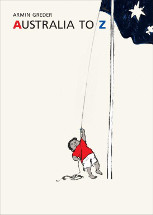Australia to Z by Armin Greder

Allen & Unwin, 2016. ISBN 9781760113186
(Age: Yr 5 +) Australia to Z is Armin Greder at his
uncompromising, most confronting best. From the creator who brought
us The Island which really turned a spotlight on our
treatment of newcomers, comes this totally different alphabetical
look at Australia which is just perfect for getting students to have
a look at what it means to be Australian. While 'soft'
investigations focus on icons, anthems, heroes and food, Australia
to Z takes a much tougher look starting with the A for
Aborigine looking out and seeing a First Fleet ship on the
horizon to the deliberately juxtaposed B for Boat People
showing more recent arrivals.
This is political commentary brought into the lives of children so
they need to think and investigate. Why has Greder chosen 'calories'
for C, 'Ikea' for I, and 'Rupert' for R? But there are flashes of
humour to lighten it too, with K being for the kangaroo that springs
from nowhere in the night to take out the front of your car, and the
ominously raised finger of the umpire for O for Out! And finally,
there is Z for Zoo but the illustration is not what you would expect
- but is perhaps the most poignant of all. This really is Australia
under the microscope as the title page image suggests.
The choices make us think about how others see us, and with Greder
being a Swiss immigrant, his perception may be sharper than others.
But the inclusion of Advance Australia Fair almost as an
appendix is a masterstroke - how different are the words we sing to
the life we live?
Often in an 'alphabet book' the illustrations are more important
than the text itself, but in this one the two are interdependent.
Yes the text is biting but it is the powerful illustrations that
accompany it that add the extra punch. Why are Rupert's eyes blank?
What does the picture of the Digger represent? With bold black
strokes and a minimal palette, each image says all it needs to say
and leaves a lasting impression long after the page has been turned.
Working in a highly multicultural school which has a significant
population of children who come to learn English for the first time
so they can work comfortably in their neighbourhood schools later,
it never ceases to amaze me how these kids get along and understand
each other so well without a common language let alone skin colour.
There are many quotes and memes online that state "Children are not
born racist - they learn to hate" and that is certainly my
experience. Using Australia to Z in a focus on identity and
belonging would be a most powerful way to raise issues, investigate
and discuss them because knowledge leads to understanding,
understanding leads to tolerance and tolerance leads to acceptance.
Maybe this year's Year 5 and 6 students will be a turning point as
they create their own with the theme "what could be" . . .
Barbara Braxton